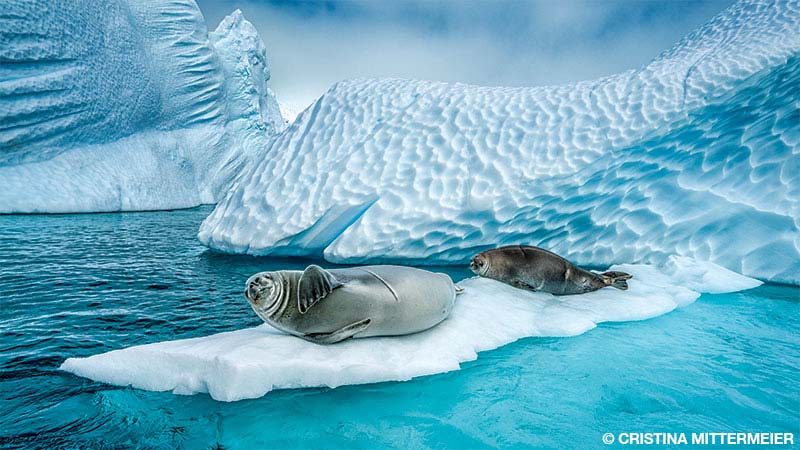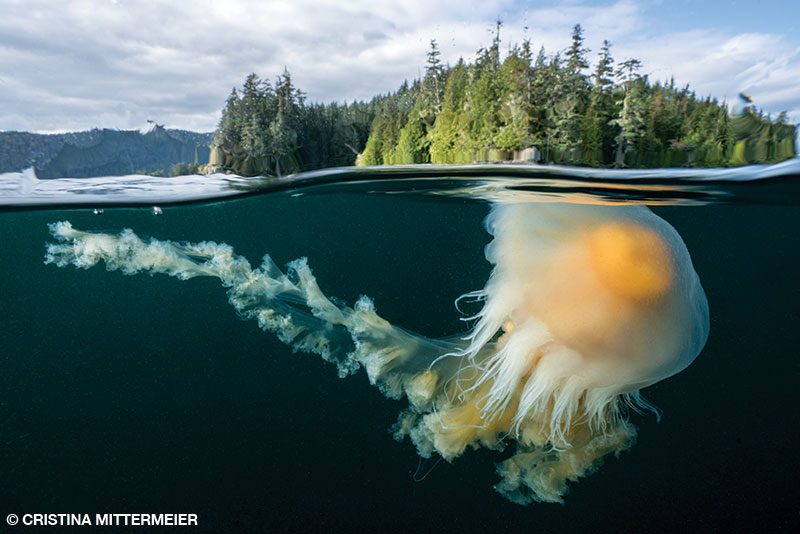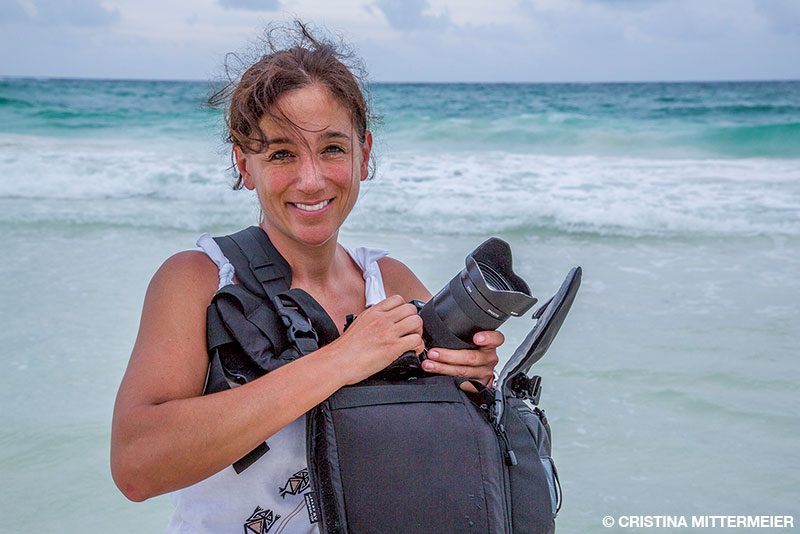It seemed like I knew her before the first time we spoke, such is her presence within the conservation photography community. I certainly knew her images, and her social media posts with insightful captions reveal her deep commitment to ocean ecology issues. She posts an almost daily combination of words and photos so compelling that 1.4 million people follow her work on Instagram, making her the platform’s third-most-followed wildlife photographer, according to statistics database Statista. Her partner in life and adventure, Paul Nicklen, has amassed 6.8 million followers to be Instagram’s most-followed wildlife photographer. Together they are quite the social media powerhouse.
Not so long ago the metric to judge a photographer’s reach was the frequency and circulation of the printed page. While that is still important, social media engagement has become increasingly dominant. In the Fall 2019 issue of Adventure Journal, Mittermeier recounted how they almost casually fell into that space. When asked about growing her following, she answered, “When social media came out, we started posting on Instagram, and nobody had any idea that it was going to become such a big deal.” As she and Paul watched their following increase, they realized that a meaningful purpose behind their captions and photos resonated with more viewers. That was the acorn from which the mighty oak of their nonprofit foundation, SeaLegacy, has grown since its founding in 2014.

Their website, sealegacy.org, reflects the conservation consortium Mittermeier and Nicklen have created. Based on three unifying concepts — education, impact media and innovative solutions — and with the intertwined goals of increasing the audience for their message and the amount of funding available to ocean conservation, their modus operandi is to do the following:
• imagine and execute photographic expeditions to document threats to the oceans
• use their media influence to create global campaigns targeted to effecting change
• amplify and fund projects for sustainable improvement to our ocean habitats
• use visual storytelling to stimulate positive change for the issues facing our oceans
Given their expedition ethos, it was appropriate that our interview was via satellite phone while Mittermeier and Nicklen were at sea in the Bahamas on the maiden voyage of their new expedition catamaran, SeaLegacy 1.

Stephen Frink: You were born in Mexico City in 1966 and graduated with a degree in biochemical engineering in marine sciences. Now you are on the deck of a sailing catamaran in the Bahamas. What led you to where you are today?
Cristina Mittermeier: The ocean was not a part of my daily life as a little girl in Mexico City, but somehow the idea of swimming with dolphins had already captured my imagination. The Jacques Cousteau documentaries we watched on TV propelled that enduring fantasy. I remember a day when my father brought home a beautiful coffee-table book about Cousteau’s adventures, but instead of giving it to me, he gave it to my brother. It was painful that my dad had failed to recognize my interest, but my brother soon got bored with it, so it eventually became mine. I pored over every page and imagined myself participating in their voyages of discovery. I still have the book, and it is a constant reminder of my journey to get here.
I had ongoing discussions with my parents in those years; I wanted to become a marine biologist, but my dad wanted me to have a more conventional career. My mother was my champion, and I eventually made my way to university to study fisheries biology. As part of my education, I was an observer on industrial fishing boats. It was my first time seeing the incredible amount of wasteful bycatch from industrial fishing, and I then understood the devastating power of our tools for marine exploitation. Imagine there are 10 pounds of dead sea creatures on the deck for every pound of live shrimp. That sight was profoundly shocking, but it has taken me another 20 years to be able to voice my concerns and do something about it — and it was a circuitous route. The silver lining was that my university education required a comprehensive dive course for graduation, so I have been a diver since 1987.
My next chapter took me to Akumal on Mexico’s Riviera Maya, where I worked as a biologist and diver for a hotel. When Conservation International launched a program in the Yucatán, they hired me to show them the indigenous wildlife. The organization’s president was Russell Mittermeier, a world-renowned primatologist and herpetologist. One thing led to another; we were married for 20 years and raised three children together before divorcing in 2011, but we’re still colleagues and continue to work together. Another significant change from that era was my move to Washington, D.C., where I gained a front-row seat to how conservation diplomacy works.

Did that make you a city dweller? How did your path to photography evolve?
We lived in the woods on the outskirts of D.C., and I still went on expeditions into remote nature reserves and indigenous communities. I enjoyed the dichotomy of spending time in meetings with scientists and government officials trying to carve out policy and then spending time in the field with photographers and scientists. During this time, I realized that many of the world’s best photographers could not directly access conservation action in the field. They had the magazines they worked for or the stock photos they sold but no means of channeling their passion for conservation into action.
Creating the International League of Conservation Photographers (ILCP) was my attempt to give agency to a collective of creatives supporting conservation through ethical photography and filmmaking. The concept resonated with some of the biggest names in nature photography, including Art Wolfe, James Balog, David Doubilet, Tim Laman, Steve Winter, Thomas Mangelsen, Joel Sartore, Brian Skerry, Thomas Peschak, Nick Nichols, Frans Lanting and, of course, Paul Nicklen, to name a few. They were some of the 40 photographers who became our founding members. These artists were tired of “just” taking pictures and were passionate about a shared vision that images could influence policymaking. Today the ILCP has more than 100 members in more than 20 countries.

How did you get started in underwater photography?
By the time I established the ILCP in 2005, I had spent 15 years raising children and had been diving only a few times since I left the Yucatán. I had traveled extensively and was shooting a lot, specializing in cultural stories about indigenous people. Sadly, my initial desire to be a new-generation Cousteau was mostly dormant. Then I met Paul Nicklen. He was my first underwater photography mentor and taught me the basics, loaned me one of his housings and encouraged me to shoot at every opportunity. From him I learned the fundamental premise of underwater photography: First be an extraordinarily capable water person, and then look through a viewfinder.
Underwater photography is like another language that requires awareness and nuance. Photos are like phrases in that they need proper composition and structure and when properly constructed can be poetic. I was aware and respectful of pioneers and heroes such as David Doubilet but cognizant that not a lot of women were doing this work. I hoped to create images no one had seen before and to do it with a feminine angle, but I also found that I wasn’t interested in macro or action photography.
I want to share the beauty, poetry and mystery of the lives of marine creatures. I am also interested in the relationship between coastal indigenous communities and the ocean. I do as much as 90 percent of my underwater photography while freediving.

What are your brand preferences for your underwater cameras and housings?
I began my underwater work using a Seacam housing and Canon system that Paul loaned me, but in 2008 I was inducted as a Sony Artisan of Imagery. I now shoot a Sony a7R IV and Sony a9. Both are mirrorless cameras, but I like the a7R IV when I need big files for my fine art and gallery work. The a9 is excellent in the field when I need both speed and performance. I use a Nauticam housing, often with a 28mm lens and a wet/wide lens mounted outside the port. I also shoot with a 12-24mm zoom lens in a Zen dome port with Inon strobes, unless I am doing available-light work with sperm whales or something similar.
One of my first underwater photos is an over/under shot of seagrass. Over/unders are still one of my favorite techniques for storytelling. I think shooting splits is somewhat voyeuristic. People see the surface of the ocean and can only imagine what’s below. I like to reveal the mystery, like the enormous whale shark swimming next to your boat or the huge jellyfish coming too close to you.

In your Adventure Journal article, you commented on apocalypse fatigue, something any conservation photographer must face. Is it depressing to be in these wild and beautiful places, yet to understand the pressures they face and how dramatically these issues affect the planet?
Of course, we see awful things: whales that have been hit by ships, turtles tangled in nets, sea birds with their stomachs full of plastic and sharks being finned and thrown overboard while still alive. Paul and I do a lot of work in the polar regions, and the effects of climate change are obvious and alarming. There is so much death happening beneath the surface, out of the view of so many. Yes, I have nightmares about it, but I am generally a positive, solution-oriented person, and I feel my photography can shine a light and make a difference.
We all carry cameras now in our smartphones. People speak photography, so it is a good way to invite people into the conservation conversation. In this conversation we want to show what’s beautiful and special but also what may be in dire peril. Perhaps most significantly, we must show our audience an opportunity to act positively and to hopefully attain a solution. That’s what we want to do with SeaLegacy and now the voyages of SeaLegacy 1. We want to tell stories that inspire, engage and ultimately motivate action.
Instagram: @Mitty
Facebook: @cristinamittermeier
www.cristinamittermeier.com
www.sealegacy.org


Explore More
Watch two short videos about Cristina Mittermeier and then see more of her photography in a bonus photo gallery.
© Alert Diver — Q1 2021